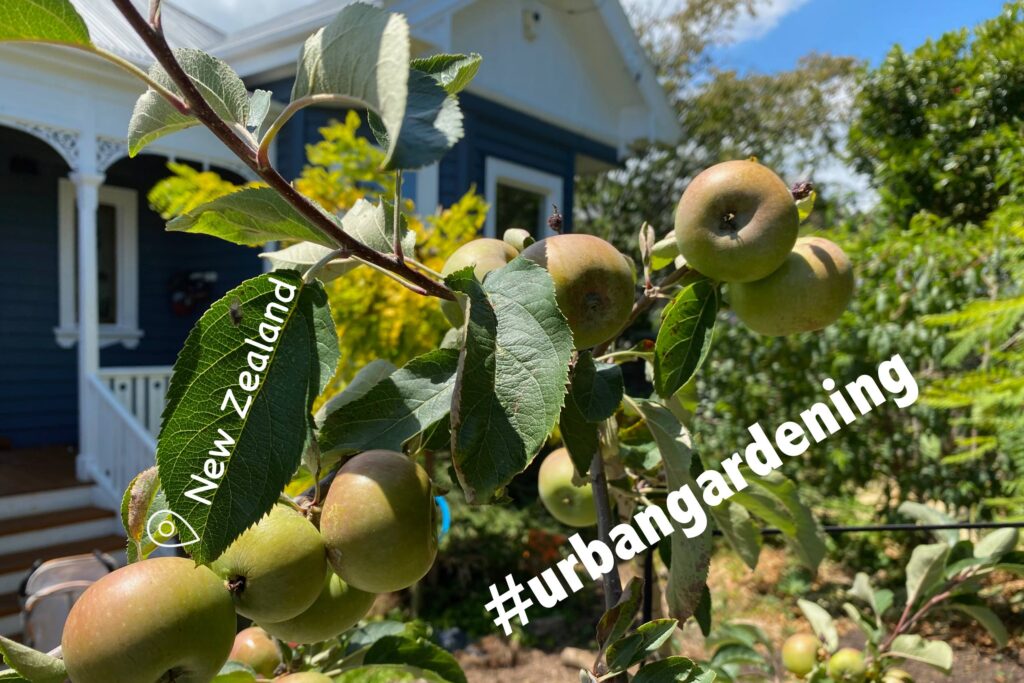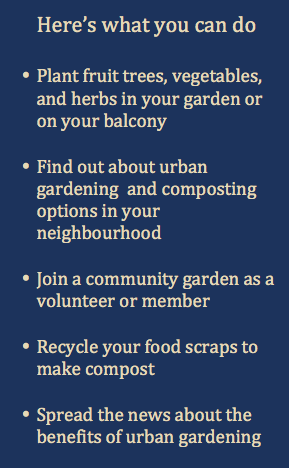Urban Gardening (NZL)

In New Zealand’s cities we discover various ways of urban gardening and learn about the many benefits of growing food in cities.
Contributes to achieving the following UN Sustainable Development Goals:
“This used to be the driveway,” Jonna points out while we walk over mulch piled up next to the house. “We are going to plant apple trees here.” We are visiting her and her husband Bob in Auckland. They live just outside the centre and have big plans for their garden. “We took a permaculture course and are now turning theory into practice. The front garden is turned into an orchard and we’re planting vegetables in the back garden” Jonna explains. “For our and our children’s health we think it is important to eat fresh, spray-free fruit and vegetables.” It’s music to our ears. “I love the idea of living in the middle of a city but also growing your own food!” Ivar beams. “In that case you can get started right away”, Jonna suggests and hands him a spade.
Trees Replace Asphalt
“Most houses in this neighbourhood have a long driveway to a garage behind the house,” Jonna explains. “We thought that was a waste of space and turned the garage into a guesthouse. We have removed the driveway’s pavement but the ground is still very compact. That’s where you come in”, Jonna says with a smile. “So I can break up the soil?” Ivar asks. “Exactly! Then we sprinkle gypsum and lime powder over it and cover the soil with a thick layer of mulch to make the earth fertile again.” Ivar goes to work and with Bob’s help prepares the ground for the apple trees. They are in pots next to the house, ready to be planted.
Grass Out, Vegetables In
Jonna and Floris continue the tour in the backyard. Jonna explains that when they bought the house, the backyard was all grass. “We thought that was a shame, because you can do so much more in a backyard. So we removed most of it and put in a vegetable garden and chicken run.” There was also room for a trampoline and sandbox for the children. While Jonna explains about the different herbs and vegetables that she grows, one of the children picks a ripe cherry tomato. By having fruits, herbs, and vegetables in their own garden, the children learn at an early age that growing their own food is something natural. What’s more, they taste how delicious homegrown food can be.
Opt For Diversity
After six weeks of doing boat maintenance, we stay with Jonna and Bob again. There are no traces of the former driveway left and in the front garden the apples and peaches are almost ripe. “Our fruit trees come from the Koanga Institute,” Jonna tells us. “They nurse a wide variety of heritage species that were traditionally planted in New Zealand. This is remarkable because nowadays almost all fruit trees are standardized so growers can supply supermarket chains and exporters with the same varieties on a large scale. This is how monocultures are created. The variety of trees at Koanga, on the other hand, is good for biodiversity. They are also well-adapted to local climates here, and the fruits are very nutritious.” We cannot wait to return when the fruit is in season.
Gardening Without Your Own Garden
Not everyone has a garden to grow their own food. What if you live in an apartment, for example? You can put planters with herbs or tomatoes on your balcony. And in many places, you can join a community garden. In New Zealand, they can be found in every major city In Auckland, we visit Daldy Street Community Garden. It’s in the city centre, a stone’s throw from the America’s Cup village. The first things we see when we get there are large planters. Each of them is unique and managed by someone else as their little garden. Some have fruits and vegetables, others are full of flowers and ornamental plants that attract bees and other insects. Here, too, biodiversity in Auckland is enriched.
Richard is the community garden’s manager and explains the concept to us. “Everyone is in charge of their own garden but there are also many social activities. Better gardening is the common theme of those. For example, we have courses about bees or composting. That way, our members not only learn how to grow their own food better, but they also get to know their neighbours.” We look at the newly-built apartments around us and imagine their residents meeting down here to tend to their mini-gardens. “Isn’t the land here too expensive for urban gardens?” we ask Richard. “Land here is certainly expensive but the council has given us permission for our community garden here. If this land is needed for construction, we will move the planters to another location with a forklift.” Those planters prove to be quite handy in urban environments.
Closing The Cycle
A few weeks later we are in the capital Wellington. Next to a hospital parking lot we find Kaicycle. There are no planters here. Instead, it’s a large garden filled with vegetable beds and fruit trees. There is even a greenhouse where seeds and seedlings are grown until they are big enough to move outside. Managers Rory and Sheldon explain that this is municipal land: “It used to be a somewhat neglected park. Construction is not allowed here because there are pipelines underground. We were given permission to turn it into an urban garden, so now it is a little farm in the middle of town” Rory says proudly. What is special about Kaicycle is that they collect food scraps from households to compost on their site. When it is ready, the compost is used for the vegetable beds. Volunteers help with all aspects of gardening. It helps Kaicycle to run the mini-farm while the volunteers learn skills to garden better. Kaicycle follows a community-supported agriculture (CSA) model. That means that the harvest is sold to members. Each week, they can collect a box of seasonal vegetables for a fixed amount. The way they garden – organically, with composting and the help of volunteers – as well as the way they sell their produce based on the CSA model stem from the same philosophy. “Our objective is to be circular and close the food cycle” Sheldon says. “Hence our name: kai means food in Maori and cycle stands for the circular model we follow.”
In and For The Community
The more urban gardens we visit, the more aspects of it we get to know. In Christchurch, open spaces between new buildings are a stark reminder of the devastating earthquake in 2011. Cultivate has created an urban garden in such an open space. They work with young people from difficult backgrounds. The garden helps these young people grow in more than one sense. As there is always something to do and every activity has a purpose, the youngsters feel useful and appreciated. By gardening, they learn new skills and develop themselves to function well in their communities.
In Auckland we find a community garden with a social mission. The council there has joined forces with local Maori representatives to develop an urban garden. The vast site borders a neighbourhood with social housing apartment buildings. “Many people here have little money to spend. Fruit and vegetables can be too costly for them. From us, they can get fruit and vegetables for free,” says one of the volunteers from Ngāti Whātua Ōrākei. Although the garden is not finished yet, we can see that many veggies are already growing. “When you see the happy faces of the people who come here to get food, it makes all the hard work so rewarding!” the volunteer says with a broad smile. The garden not only enriches the neighbourhood aesthetically, it also enriches biodiversity and contributes to a healthier population. All thanks to freshly grown, organic vegetables.
More Than Growing Food
“I now understand why urban gardening is so popular in New Zealand,” says Floris after visiting community gardens all over the country. “I expected city dwellers to embrace them. Who doesn’t love to eat fresh, healthy, local, poison-free food, after all? But it was a surprise that so many other aspects are involved” he admits. Everyone with a garden of their own can often grow a portion of their own food quite easily. For others, community gardens offer a solution. Not only can they put their green fingers to good use, but they can also get in contact with their neighbours. Finally, there are the larger gardens that are maintained almost professionally and often have a social function, as we saw in Christchurch and Auckland. Gardening is used there to develop young people or to help underprivileged people eat healthier and cheaper.
All these types of urban gardens clearly have sustainability benefits. Each apple you pick from your own garden saves transport and energy. Every patch of grass that is replaced by a tree, plant, vegetable, or flower enriches biodiversity and stores more carbon. Through composting the nutrient cycle can be closed and soil health is improved. Food waste is reduced, as those who put in the effort of growing food themselves will not want it to go waste. And finally, it’s not a stretch to believe that those who learn about natural processes and growing methods also buy more sustainably grown food. For all these reasons, we have become fans of urban gardening. Now it’s up to us to expand our very modest boat garden (currently consisting of a basil plant). What will you do?

Related Sustainable Solutions

Power to Perennials (USA)
Perennial grains: revolutionizing farming by nourishing the soil, capturing carbon, and securing our future food supply.

Smart with Seaweed (NZL)
In New Zealand we learn how seaweed can be used to improve soil biology, with significant environmental and economic benefits for all farm types.

Urban Gardening (NZL)
In New Zealand’s cities we discover various ways of urban gardening and learn about the many benefits of growing food in cities.

Improving Children's Health with Veggies (PER)
High in the Peruvian Andes, poor school children learn how to grow and cook healthy, organic veggies. An example for the world?

Meatless in Buenos Aires (ARG)
In the beef capital of the world, the tide is turning in favour of plant-based diets. Good news for human health, animals, nature, and the climate.

Alda's Organic Neighbourhood Farm (URY)
Organic farmer Alda explains how fertile soil enables her to grow food without poison, increases biodiversity, and has positive climate effects.

Natural Coffee (BRA)
We visit a coffee forest in Brazil and learn all about the environmental and social benefits of agro-ecology.

Food Forests (BRA)
In Brazil, Ernst Götsch explains to us how to grow healthy food in cooperation with the forest.

Bananalogic (ESP)
On the Canary Island of La Palma in Spain, we discover that the logical way to grow bananas is with butterflies instead of poison.

Olive Oil (GRC)
In Greece we take a closer look at olive oil, which is an integral part of Greek history and culture. We discover ways of growing olives sustainably.

Slow Food (ITA)
The Slow Food movement promotes food that is good for the consumer, good for the producer, and good for the planet.




























